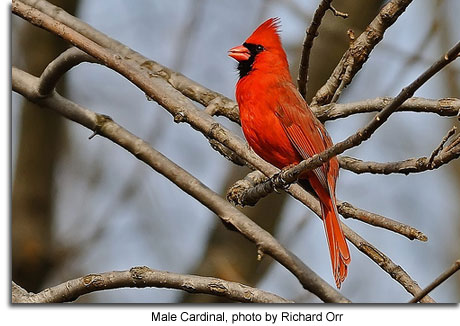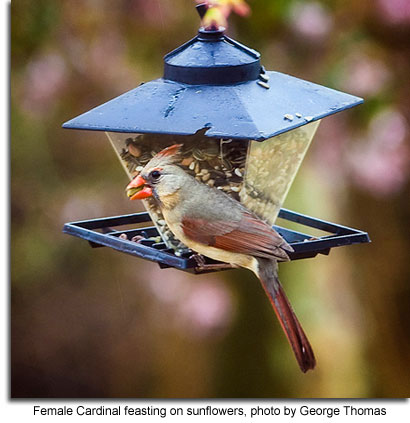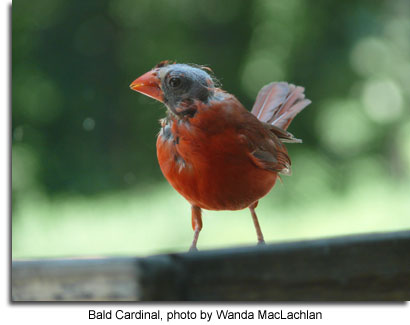Cardinals belong to a group of birds called "grosbeaks", meaning that they have a thick bill especially adapted for cracking open and eating seeds.
Male cardinals, or redbirds as they are sometimes called, can be distinguished from other birds by their bright red color, a black patch around the bill and a red crest on the head. Females are olive-brown with red wings and a red crest.

Natural History
Besides their red plumage, cardinals are also known for their large repertoire of songs. Unlike most songbirds, cardinals sing all year long. In addition to their famous "cheer, cheer, cheer" song, they often throw in a "wheet, wheet, wheet", or "chew, chew, chew", or a "cheedle, cheedle, cheedle". During courtship, a male is often seen feeding a female. He will continue to feed her while she sits on the nest. While most songbird singing is restricted to the males, female cardinals are known to sing to the male while sitting on the nest.
Cardinal nests are composed of dry leaves, twigs, grape vine and dry grass. The female normally builds the nest and chooses thickets, briars or young evergreens that offer protective cover from weather and predators. Cardinals also like to nest near streams, which supply drinking and bathing opportunities.
Cardinals nest from March through August and lay two to five eggs at a time. The eggs can be gray, buff, or light green in color with spots of gray and brown. Females incubate the eggs for 12-13 days and the young leave the nest when they are about ten days old. A pair of cardinals may have two to four broods during one season. The male tends to the newly fledged young while the female begins incubating the next clutch of eggs. Producing this large number of young each season helps the cardinal species survive.
One of the dangers cardinals face is becoming a parent to a Brown-headed Cowbird. Cowbirds lay their eggs in other bird's nests and destroy the host's young in the process. The adopted parents then raise the cowbird chick as if it was their own.
How to Attract Cardinals
You can attract cardinals to your yard by providing food, water and cover plants for nesting and resting. In the wild, cardinals eat a variety of foods including insects, fruits, berries, seeds and farm crops. They also eat caterpillars, grasshoppers and beetles. At feeding stations, cardinals prefer black oil sunflower seeds, millet, cracked corn, peanut butter, nuts, fruit and mealworms.
Cardinals prefer to eat on a tray, a platform type feeder, or on the ground. Favorite seeds include sunflowers and safflowers, but they are known to eat over a hundred kinds of fruits and seeds in the wild. Attractive garden plants include brambles, sumac, cherry, dogwood, grape, mulberry, blueberry, elderberry, tulip poplar and hackberry.
For cover, cardinals prefer brushy woodlands, streamside thickets, orchards, swamps, suburban gardens and parks. They like to roost and nest in dense thickets, evergreens and hedges. Evergreens such as Eastern Red Cedar (Juniperus virginiana) and American Holly (Ilex opaca) are great shelter trees for cardinals and other birds. During breeding season, they are attracted to dense thickets of brambles, shrubbery and vines for nest building materials and placement.
Planting native trees and shrubs like American holly will attract cardinals to your yard.

Cardinals and Windows
Cardinals are highly territorial of an area they have chosen for nesting. Males vigorously defend their territory from other male cardinals and will even attack their own reflection in a window or car mirror. Even females will constantly attack windows, which can be quite distressing to people living inside the house. To help discourage this behavior, hang a sunscreen or towel to "break" the reflection of the bird in the particular window or mirror. The towel may look funny on the window, but it will save you from worrying about the birds harming themselves, and it will help the birds get on with the business of nesting and defending against real threats. Cardinal window attacks are generally restricted to the spring and early summer, when birds are most concerned about their nests.
Bald Cardinals
While cardinals do not molt into duller plumage in the Fall, some cardinals experience drastic molts that often leave them ‘bald’. For some reason, many cardinals lose all of their head feathers at the same time, leaving a bald bird behind. While in some cases, the loss of feathers are a result of lice or poor nutrition, most of the time, new feathers will grow in on their own to produce the wonderful plumage cardinals are known best for.

Invite Wildlife to Your Backyard!
For more information, please contact:
Maryland Department of Natural Resources
Wildlife and Heritage Service
Tawes State Office Building, E-1
Annapolis MD 21401
410-260-8540
Toll-free in Maryland: 1-877-620-8DNR
[email protected]
Acknowledgements:
- Male Cardinal, photo by Richard Orr
- Female Cardinal feasting on sunflowers, photo by George Thomas
- Bald Cardinal, photo by Wanda MacLachlan